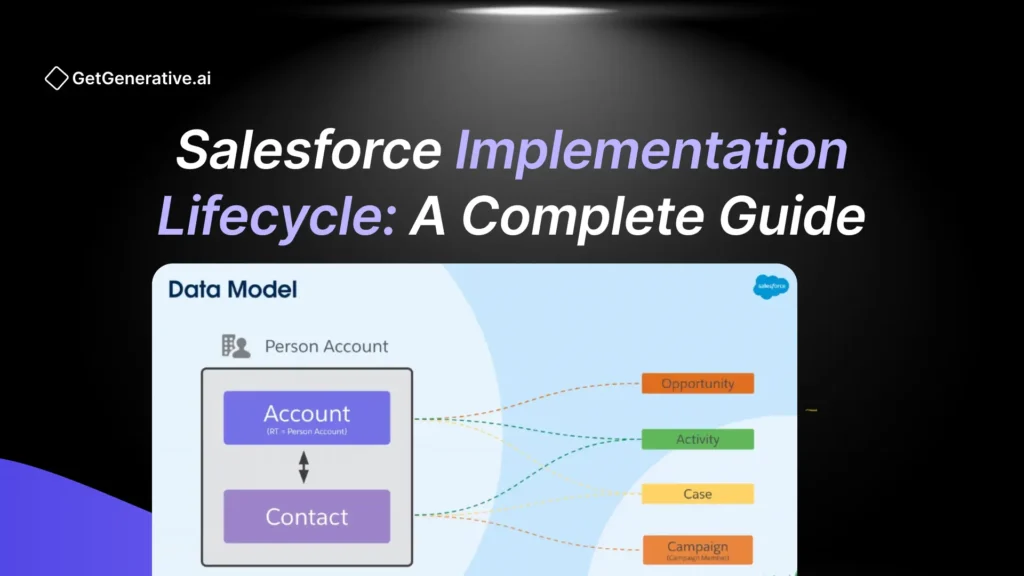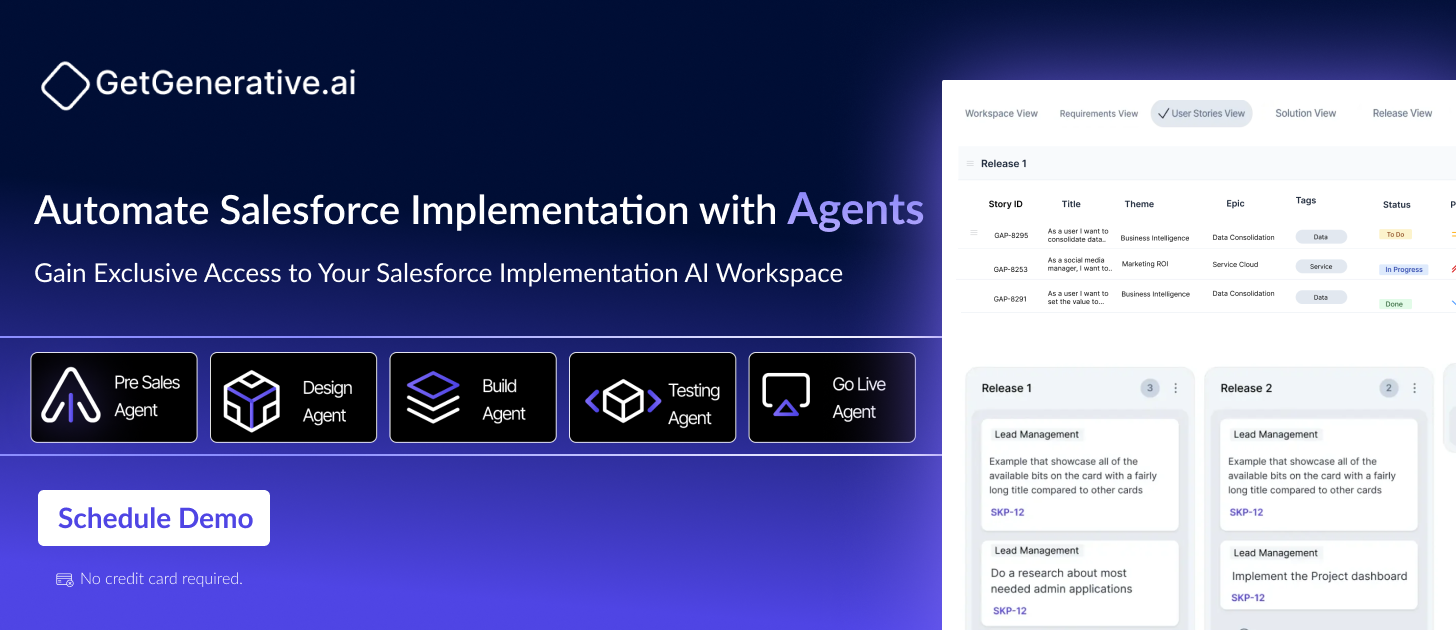Salesforce Implementation Lifecycle: A Complete Guide 2025
Salesforce has become the gold standard for businesses aiming to enhance their operations and foster stronger customer relationships. However, implementing Salesforce isn’t as simple as flipping a switch. It’s a journey that involves careful planning, execution, and optimization.
This blog dives deep into the Salesforce implementation lifecycle, breaking it down into actionable phases, challenges, and best practices to help you navigate the process successfully.
The Core Phases of the Salesforce Implementation Lifecycle
Implementing Salesforce requires a structured approach. Each phase builds on the previous one, ensuring a smooth transition and maximum ROI.
Discovery and Planning
The foundation of any successful Salesforce implementation lies in meticulous planning. This phase involves defining your goals, analyzing existing processes, and creating a strategic roadmap.
- Set clear objectives aligned with your business needs, such as improving customer retention or streamlining sales pipelines.
- Map existing workflows to identify inefficiencies and opportunities for improvement.
- Develop a project timeline with defined milestones and resource allocations to keep all stakeholders aligned.
Design and Customization
Customization is the heart of Salesforce’s adaptability. This phase focuses on tailoring the platform to meet your unique requirements.
- Configure workflows to automate repetitive tasks like lead nurturing or order processing.
- Build user-friendly dashboards to simplify navigation and ensure high user adoption rates.
- Utilize tools like Apex and Lightning Components for advanced customization, creating functionalities that align perfectly with your business processes.
Data Migration
Data migration is a critical step that often determines the success of your Salesforce implementation. Poorly managed data can lead to inefficiencies and errors.
- Conduct a thorough data audit to identify inconsistencies, duplicates, and outdated information.
- Use robust data migration tools to ensure a seamless transfer of information from legacy systems to Salesforce.
- Map fields accurately to maintain data integrity and structure within the new platform.
Testing and Validation
Testing is where all the pieces come together. Rigorous testing ensures that every component functions as intended before going live.
- Perform User Acceptance Testing to validate that the platform meets user expectations.
- Use sandbox environments to safely test integrations, workflows, and customizations.
- Identify and resolve potential issues early to avoid disruptions post-launch.
Deployment and Go-Live
The deployment phase marks the culmination of your implementation efforts. A smooth go-live process ensures minimal downtime and maximum efficiency.
- Train end-users to familiarize them with the platform’s features and functionalities.
- Monitor system performance closely during the initial days to address any unforeseen issues.
- Gather feedback to fine-tune the setup and enhance user satisfaction.
Also Read – Fast-Track Your Salesforce Implementation With These Quick Win Strategies
Challenges in Salesforce Implementation
Even with careful planning, challenges are inevitable. Understanding these hurdles can help you prepare better.
Data Migration Complexities
Migrating data from legacy systems often uncovers inconsistencies, missing information, or duplication. Addressing these issues requires meticulous planning and robust tools.
Resistance to Change
Employees accustomed to existing workflows may resist adopting a new system. Providing comprehensive training and highlighting the benefits can ease the transition.
Integration Issues
Ensuring Salesforce integrates seamlessly with existing tools is critical but can be technically demanding. Working with experienced Salesforce consultants can simplify this process.
Managing Expectations
Unrealistic timelines or unaligned objectives can derail a project. Setting clear expectations and maintaining transparent communication throughout the process is crucial.
Best Practices for a Smooth Implementation
Adopting proven strategies can make your Salesforce implementation more efficient and impactful.
Involve Stakeholders Early
Engage teams from different departments to ensure the platform meets cross-functional needs. Early involvement also fosters buy-in and smooths adoption.
Prioritize User Training
A powerful tool like Salesforce is only as effective as the people using it. Regular training sessions, accessible documentation, and hands-on workshops can boost user confidence and proficiency.
Maintain a Feedback Loop
Post-implementation feedback is essential for continuous improvement. Encourage users to share their experiences and suggestions to identify areas of improvement.
Also Read – Salesforce Implementation Best Practices Guide 2025
Ongoing Maintenance and Optimization
Salesforce implementation doesn’t end with deployment. To fully leverage its potential, continuous monitoring and optimization are essential. Regular updates, user feedback, and system improvements ensure your Salesforce setup remains aligned with evolving business needs.
Regular Updates and Enhancements
Salesforce releases updates quarterly, introducing new features and functionalities. Keeping your system up to date ensures access to the latest tools and enhancements. These updates often include:
- Advanced automation features
- Enhanced analytics capabilities
- Improved integration tools
Encouraging your team to explore Salesforce Trailhead modules can help them stay informed about these updates and integrate new features seamlessly.
Continuous Monitoring
Monitoring user adoption and platform performance is critical for long-term success.
- Use dashboards to track key metrics like lead conversion rates and customer satisfaction scores.
- Identify bottlenecks or underutilized features to optimize workflows.
Feedback Loops for Improvement
Gather regular feedback from users to refine the system. Address pain points promptly and introduce additional customizations or integrations as required.
How to Choose the Right Salesforce Partner
Selecting the right Salesforce implementation partner can significantly impact your success. The ideal partner should bring expertise, flexibility, and a clear understanding of your business needs.
Criteria for Selection
- Look for a proven track record with similar projects.
- Verify certifications like Salesforce Administrator or Salesforce Consultant credentials.
- Assess their ability to provide ongoing support post-implementation.
Questions to Ask Potential Partners
- What is your experience with businesses in our industry?
- How do you handle data migration and integration challenges?
- Can you provide client testimonials or case studies?
Also Read – What Is a Salesforce Implementation Partner?
Cost of Salesforce Implementation
The cost of implementing Salesforce can vary widely based on factors like project complexity, team size, and customization needs.
Factors Influencing Cost
- Scope of Customization: The more tailored your Salesforce setup, the higher the cost.
- Integration Requirements: Connecting Salesforce to existing systems often requires specialized tools and expertise.
- User Training: Comprehensive training programs for your team can add to the overall expense.
Tips to Stay Within Budget
- Prioritize features that align with your immediate goals.
- Use Salesforce’s built-in tools where possible to reduce dependency on custom development.
- Allocate resources wisely, balancing cost and functionality.
Conclusion
The Salesforce implementation lifecycle is a strategic process that requires meticulous planning, execution, and ongoing optimization. By understanding its core phases, overcoming challenges, and adhering to best practices, businesses can unlock Salesforce’s full potential. Whether you’re a small startup or a global enterprise, a well-executed implementation sets the foundation for sustained growth and innovation.
Visit GetGenerative.ai to learn more!




